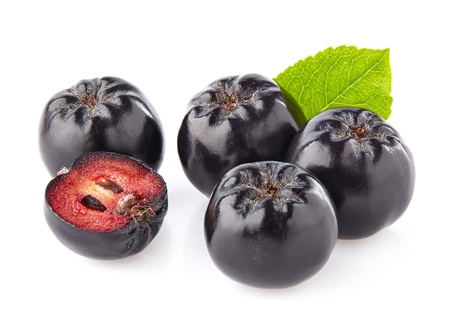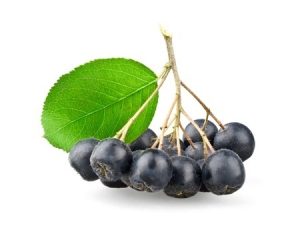
The Black Chokeberry (Aronia melanocarpa (Michx.) Elliot. Family: Rosaceae) provides product developers with a strong red-purple colour for use in beverages. Any more to be said ? Yes indeed. It is a very rich source of polyphenols. It is native to North American Eastern forests and it could be argued to be a ‘superberry’ in marketing terms. It is popular in Eastern Europe, especially Poland which has conducted the majority of the research into the fruit. Most fruits have an antioxidant potential and this one would successfully vie with others in this league with a reported ORAC value of 7.3 mmoles/gram fruit.

Composition
Much of the benefit comes from its procyanidins, anthocyanins and phenolic acids – one of the highest known. The anthocyanin composition totals 1.5 g/100 fresh fruit and is built around various sugars of the cyanidin and pelargonidin aglycones, mainly arabinoside and galactoside (Oszmianski and Sapis, 1988; Wu et al., 2004; Sueiro et al., 2006). The flavonoids are mainly quercetin derived with one peculiar version called glucoronide of eriodictyol (Slimestad et al., 2005). There are some excellent reviews on its health benefits (Kulling and Rawel, 2008; Chubasik et al., 2010; Kokotkiewicz et al., 2010; Denev et al., 2012).
Clinical Studies
It is claimed, whether as berry or juice to be effective against cardiovascular disease, reduce hypertension, impact on cancer, reduce inflammation, support immunity, improve gastric metabolism and glucose utilisation, aid cognitive function and reduce cholesterol levels. The juice itself has been the subject of sports studies – one looked at the reduction in oxidative stress from a rowing ergometer exercise (Pilaczynska-Szczesniak et al., 2005). In this study, a number of factors associated with oxidative potential were assessed. Those receiving 23mg/100ml of anthocyanins had lower TBAR concentrations (an analytical measure) in blood plasma taken after 1 min. and after 24 hrs. following exercise, than those who did not receive the anthocyanins. Likewise, the activity of glutathione peroxidase was lower in samples taken immediately after exercise and also of superoxide dismutase activity after the 24-hr recovery period. They suggested that the increased intake of anthocyanins might have reduced oxidative damage due to strenuous exercise to blood cells and even promoted the endogenous antioxidant defence system.
Mouse models are commonly used to assess nutritional effects. One study monitored the effects of Aronia juice concentrate (AJ) supplementation on the prevention of obesity in mice (Baum et al., 2013). They demonstrated a potential for body fat reduction but would not speculate on the mechanisms by which this occurred.
A small human volunteer study looked at the bioavailability of anthocyanins (0.8 mg/kg body weight) before and after consumption of a drink which was a typical dosage level. Analysis of blood and urine samples before and after consumption showed that cyanidin metabolites were present in both fluids indicating metabolism (Wiczkowski et al., 2010). Subsequently, Sikora et al., (2011) observed how an Aronia extract had positive effects on blood clotting, platelet aggregation and lysis in subjects with metabolic syndrome. In this human intervention trial, the subjects took 100mg of the extract three times a day for 2 months. They observed a significant reduction in total cholesterol, LDL cholesterol and triglyceride concentrations and there was generally a marked improvement in coagulation times compared to the control.
Product Development Opportunities
The fruit is also ideal dried with a characteristic flavour which gives it a degree of uniqueness. The predominant volatile is benzaldehyde cyanohydrin (2.8 mg/kg), hydrocyanic acid (1.1 mg/kg) and benzaldehyde (0.21 mg/kg) and it has a very astringent taste. It has been tested as an additive of sorts for lemon juice at addition rates to 5% v/v (presumably single-strength level), generating a high antioxidant drink (Gonzalez-Molina, et al., 2008). Its stability was such that only 10% of anthocyanins were retained after 60 days ambient storage although the red colour was just retained and it has useful properties as a booster ingredient for a range of beverages. There are some useful web pages that describe the health benefits of the fruit – notably http://www.nutrition-and-you.com/choke-berry.html
Suppliers
Berries For Life (Fort Wayne, Ind. USA. Tel: 001 888-772-3779) (www.berriesforlife.com) supply standardised aronia supplements and are sponsored by Artemis International Inc., (www.artemis-international.com). They too cited a human clinical study where subjects taking the fruit’s anthocyanins enjoyed a decrease in systolic and diastolic blood pressure. There was also a drop in LDL oxidation as well as a drop in the inflammation factor C-reactive protein.
Product Offerings
A number of brands are using aronia juice in their product offerings. At Anuga 2015, Voglsam GmbH from Austria were presenting BIO Aronia Qi which is an 80% w/w aronia juice drink with 10% fibre that also contains green tea, hibiscus, lemon balm amongst seven other extracts. This was packaged in a 3 litre bag-in-box for easy dispensing from 50 to 100 ml aliquots. The product was presented as a functional drink to improve the immune system, protect cells and improve general nutrition.
Revised: 14th October 2015
References
Baum, J.I., Shouse, S.A., Gilbert, W., Prior, R.L., Howard, L.R. (2013) The Effect Of Black Chokeberry (Aronia melanocarpa) On The Prevention Of Obesity In C57BL/6J Mice. 27 (Mtg. Abst., Suppl.) FASEB Journal 27 pp. 861.4
Chrubasik, C., Li, G., Chrubask, S. (2010) The clinical effectiveness of chokeberry: a systematic review. Phytotherapy Res., 24 (8) pp. 1107-1114
Denev, P.N., Kratchanov, C.G., Ciz, M., Lojek, A., Kratchanova, M.G.(2012) Bioavailability and antioxidant activity of black chokeberry (Aronia melanocarpa) polyphenols: in vitro and in vivo evidences and possible mechanisms of action: a review. Compr Rev Food Sci Food Saf. 11 pp. 471–89
González-Molina E, Moreno DA, García-Viguera C. (2008) Aronia-enriched lemon juice: a new highly antioxidant beverage. J. Agric. Food Chem. 56 pp. 11327-11333
Kokotkiewicz A, Jaremicz Z, Luczkiewicz M. (2010) Aronia plants: a review of traditional use, biological activities, and perspectives for modern medicine. J. Med. Food. 13 pp. 255-269.
Kulling, S.E., Rawel, H.M. (2008) Chokeberry (Aronia melanocarpa) – A Review on the Characteristic Components and Potential Health Effects. Planta Med. 74(13) pp. 1625-1634
Oszmianski, J. Sapis, J.C. (1988) Anthocyanins in fruits of Aronia melanocarpa (Chokeberry). J. Fd. Sci., 53 (4) pp. 1241-1242
Sikora, J., Broncel, M., Markowicz, M., Wojdan, K., Chahalubinski, M., Mikiciuk-Olasik, E. (2012) Short-term supplementation with Aronia melanocarpa extract improves platelet aggregation, clotting and fibrinolysis in patients with metabolic syndrome. Eur J Nutr 51(5)pp.549–56.
Slimestad, R., Torskangerpoll, K., Nateland, H.S., Johannessen, T., Giske, N.H. (2004) Flavonoids from black chokeberries, Aronia melanocarpa. J. Food Compos. Anal. 18pp. 61–8.
Sueiro, L., Yousef, G.G., Siegler, D., de Mejia, E.G., Grace, M.H., Lila, M.A. (2006) Chemopreventive potential of flavonoid extracts from plantation-bred and wild Aronia melanocarpa (black chokeberry) fruits. J. Food Sci. 71 pp. 480–488.
Wu, X.; Gu, L.; Prior, R. L.; McKay, S. (2004) Characterization of anthocyanins and proanthocyanins in some cultivars of Ribes, Aronia and Sambucus and their antioxidant capacity. J. Agric. Food Chem. 52, pp. 7846-7856.
Leave a Reply